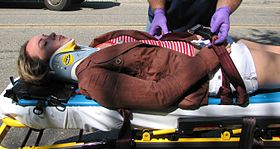| Spinal precautions | |
|---|---|
 A person with a hard cervical collar on a long board |
Spinal precautions, also known as spinal immobilization and spinal motion restriction, are efforts to prevent movement of the spine in those with a risk of a spine injury. [1] This is done as an effort to prevent injury to the spinal cord. [1] It is estimated that 2% of people with blunt trauma will have a spine injury. [2]
Uses
Spinal immobilization was historically used routinely for people who had experienced physical trauma. [3] There is; however, little evidence for its routine use. [3] Long spine boards are often used in the prehospital environment as part of spinal immobilization. [4] Due to concerns of side effects the National Association of EMS Physicians and the American College of Surgeons recommend its use only in those at high risk. [4] This includes: those with blunt trauma who have a decreased level of consciousness, pain or tenderness in the spine, those with numbness or weakness believed to be due to a spinal injury, and those with a significant trauma mechanism that are intoxicated or have other major injuries. [4] In those with a definite spinal cord injury immobilization is also recommended. [2]
Neck
There is little high quality evidence for spinal motion stabilization of the neck before arrival at a hospital. [5] [6] [7] Using a hard cervical collar and attaching a person to an EMS stretcher may be sufficient in those who were walking after the accident or during long transports. [4] In those with penetrating neck or head trauma spinal immobilization may increase the risk of death. [5] [8] If intubation is required the cervical collar should be removed and inline stabilization provided. [2]
Mid and low back
Spinal motion stabilization is not supported for penetrating trauma to back including that caused by gun shot wounds. [8]
Cervical spine clearance

Paramedics are able to accurately determine who needs or does not need neck immobilization based on an algorithm. [2] There are two main algorithms, the Canadian C-spine rule and NEXUS. The Canadian C-spine rule appears to be better. [9] However, following either rule is reasonable. [10]
Side effects
Concern with use include: pain, agitation, and pressure ulcers. [4] A systematic review found cervical collar related skin ulcers from the devices in 7 to 38%. [11]
If a longboard is used, cushioning it is useful to decrease discomfort due to pressure. [2] A vacuum mattress and scoop board typically results in lower pressures. [2]
Mechanism of action
Studies with volunteers have found that using a hard collar, head stabilization with rolled up towels, and a long board decrease movement of the board. [2] What impact this has is unclear. [2]
References
- ^ a b Pollak, Andrew (1999). Refresher: Emergency Care and Transportation of the Sick and Injured. p. 302. ISBN 9780763709129.
- ^ a b c d e f g h Ahn, H; Singh, J; Nathens, A; MacDonald, RD; Travers, A; Tallon, J; Fehlings, MG; Yee, A (August 2011). "Pre-hospital care management of a potential spinal cord injured patient: a systematic review of the literature and evidence-based guidelines". Journal of Neurotrauma. 28 (8): 1341–61. doi: 10.1089/neu.2009.1168. PMC 3143405. PMID 20175667.
- ^ a b Oteir, AO; Smith, K; Jennings, PA; Stoelwinder, JU (August 2014). "The prehospital management of suspected spinal cord injury: an update". Prehospital and Disaster Medicine. 29 (4): 399–402. doi: 10.1017/s1049023x14000752. PMID 25046238. S2CID 19574297.
- ^
a
b
c
d
e White CC, 4th; Domeier, RM; Millin, MG; Standards and Clinical Practice Committee, National Association of EMS, Physicians (Apr–Jun 2014). "EMS spinal precautions and the use of the long backboard - resource document to the position statement of the National Association of EMS Physicians and the American College of Surgeons Committee on Trauma". Prehospital Emergency Care. 18 (2): 306–14.
doi:
10.3109/10903127.2014.884197.
PMID
24559236.
S2CID
207521864.
{{ cite journal}}: CS1 maint: multiple names: authors list ( link) CS1 maint: numeric names: authors list ( link) - ^ a b Oteir, AO; Smith, K; Stoelwinder, JU; Middleton, J; Jennings, PA (12 January 2015). "Should suspected cervical spinal cord injury be immobilised?: A systematic review". Injury. 46 (4): 528–35. doi: 10.1016/j.injury.2014.12.032. PMID 25624270.
- ^ Sundstrøm, T; Asbjørnsen, H; Habiba, S; Sunde, GA; Wester, K (15 March 2014). "Prehospital use of cervical collars in trauma patients: a critical review". Journal of Neurotrauma. 31 (6): 531–40. doi: 10.1089/neu.2013.3094. PMC 3949434. PMID 23962031.
- ^ "THE USE OF CERVICAL COLLARS IN SPINAL MOTION RESTRICTION" (PDF). internationaltraumalifesupport.remote-learner.net. ITLS. Retrieved 10 September 2020.
- ^ a b Stuke, LE; Pons, PT; Guy, JS; Chapleau, WP; Butler, FK; McSwain, NE (September 2011). "Prehospital spine immobilization for penetrating trauma--review and recommendations from the Prehospital Trauma Life Support Executive Committee". The Journal of Trauma. 71 (3): 763–9, discussion 769-70. doi: 10.1097/ta.0b013e3182255cb9. PMID 21909006.
- ^ Michaleff, ZA; Maher, CG; Verhagen, AP; Rebbeck, T; Lin, CW (6 November 2012). "Accuracy of the Canadian C-spine rule and NEXUS to screen for clinically important cervical spine injury in patients following blunt trauma: a systematic review". Canadian Medical Association Journal. 184 (16): E867-76. doi: 10.1503/cmaj.120675. PMC 3494329. PMID 23048086.
- ^ Ackland, H; Cameron, P (April 2012). "Cervical spine - assessment following trauma". Australian Family Physician. 41 (4): 196–201. PMID 22472679.
- ^ Ham, W; Schoonhoven, L; Schuurmans, MJ; Leenen, LP (April 2014). "Pressure ulcers from spinal immobilization in trauma patients: a systematic review". The Journal of Trauma and Acute Care Surgery. 76 (4): 1131–41. doi: 10.1097/ta.0000000000000153. PMID 24662882. S2CID 23746350.